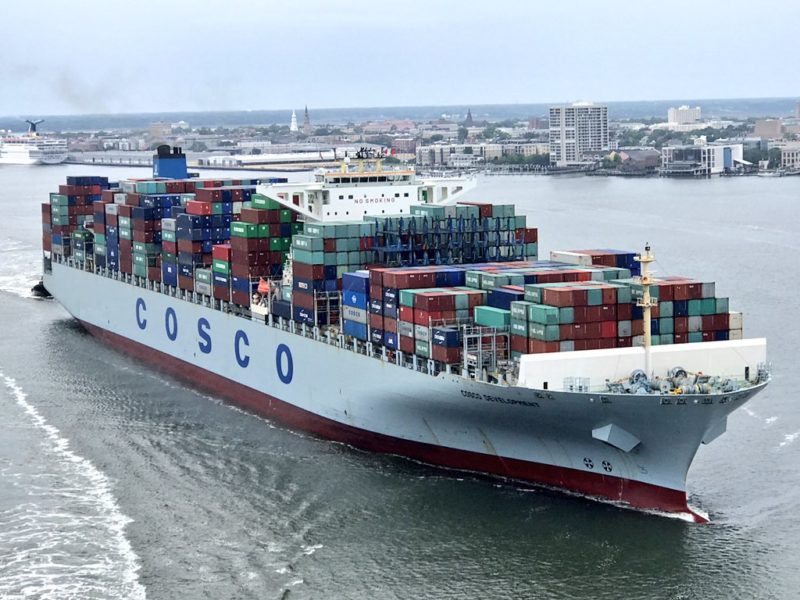


Photo: South Carolina Ports/gCaptain.com
The Chinese supersized container ship COSCO Development arrived at the port of Savannah, Georgia on May 11. It is the largest vessel ever to dock on the East Coast of the U.S. The arrival of the behemoth was long anticipated, set to occur once it completed its passage through the expanded Panama Canal. The vessel's arrival heralds a new era for big ships in U.S. ports.
The 13,092-TEU COSCO Development measures 366 meters in length and 48.2 meters in width. The Associated Press described the massive vessel in this way: “The largest cargo ship ever to visit ports on the U.S. East Coast is so long that the Statue of Liberty and Washington Monument could fit end-to-end along its deck and still leave room for Big Ben.”
Officials with Georgia Port Authority attach great importance to upgrading local infrastructure through, among other things, the Savannah Harbor Expansion Project. According to an article published on the website of Georgia Port Authority, their organization's executive director said, “Savannah is already the load center for trade in the U.S. Southeast, but deepening our harbor to better accommodate vessels such as the Development will make Savannah even more attractive to cargo owners.”
When it comes to building ports, China already has a significant head start compared to other countries. Seven of the ports on the list of the world’s top 10 ports are Chinese. Along its coastline, China boasts over 1,800 berths for ships weighing 10,000 tons and above. There are even 300-odd ports for those weighing 100,000 tons and above.
Yangshan Deep Water Port is often described as Shanghai's gateway to the world. It accommodates up to 40 percent the city's maritime traffic. The fourth phase of its construction is still in progress. Once completed, the port will have 23 berths, enabling it to easily accommodate even the largest ships.
Qingdao Port in Shandong province is also a major infrastructure success. Although the history of the port dates back to 1892, it has more recently become a leader in automation. Today, containers at Qingdao Port are loaded and unloaded by vehicles; human drivers and workers are nowhere to be found.
 Fire brigade in Shanghai holds group wedding
Fire brigade in Shanghai holds group wedding Tourists enjoy ice sculptures in Datan Town, north China
Tourists enjoy ice sculptures in Datan Town, north China Sunset scenery of Dayan Pagoda in Xi'an
Sunset scenery of Dayan Pagoda in Xi'an Tourists have fun at scenic spot in Nanlong Town, NW China
Tourists have fun at scenic spot in Nanlong Town, NW China Harbin attracts tourists by making best use of ice in winter
Harbin attracts tourists by making best use of ice in winter In pics: FIS Alpine Ski Women's World Cup Slalom
In pics: FIS Alpine Ski Women's World Cup Slalom Black-necked cranes rest at reservoir in Lhunzhub County, Lhasa
Black-necked cranes rest at reservoir in Lhunzhub County, Lhasa China's FAST telescope will be available to foreign scientists in April
China's FAST telescope will be available to foreign scientists in April "She power" plays indispensable role in poverty alleviation
"She power" plays indispensable role in poverty alleviation Top 10 world news events of People's Daily in 2020
Top 10 world news events of People's Daily in 2020 Top 10 China news events of People's Daily in 2020
Top 10 China news events of People's Daily in 2020 Top 10 media buzzwords of 2020
Top 10 media buzzwords of 2020 Year-ender:10 major tourism stories of 2020
Year-ender:10 major tourism stories of 2020 No interference in Venezuelan issues
No interference in Venezuelan issues
 Biz prepares for trade spat
Biz prepares for trade spat
 Broadcasting Continent
Broadcasting Continent Australia wins Chinese CEOs as US loses
Australia wins Chinese CEOs as US loses